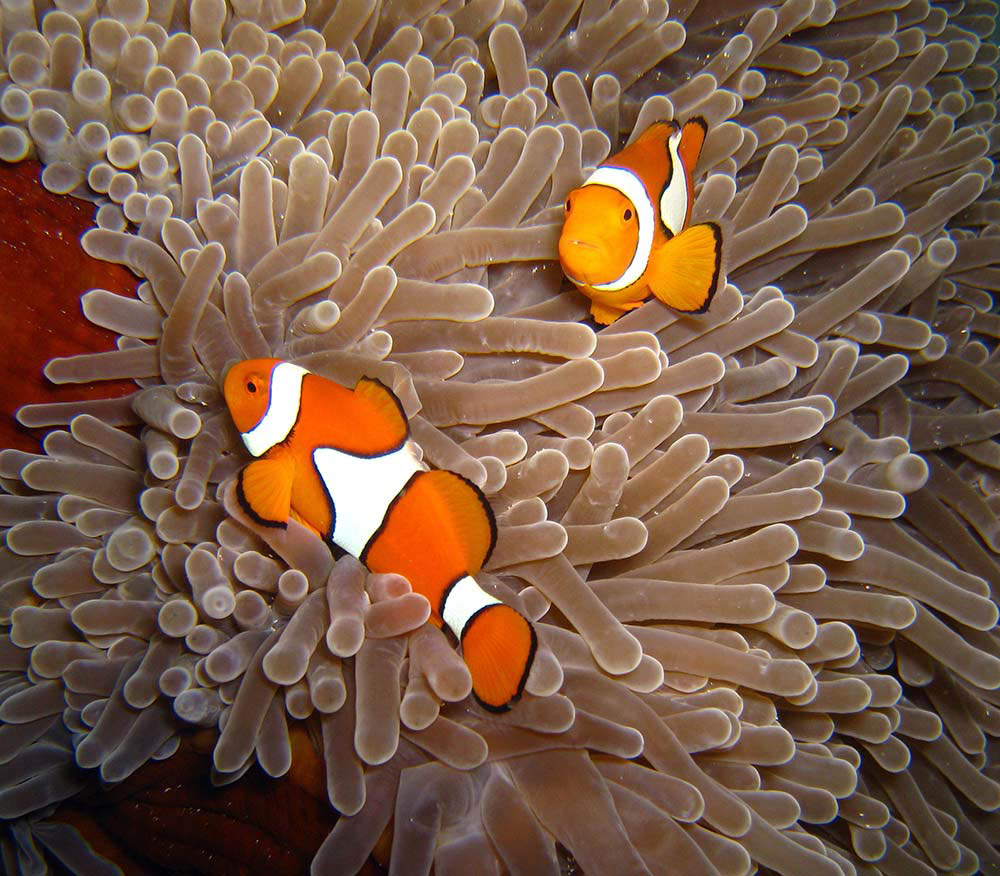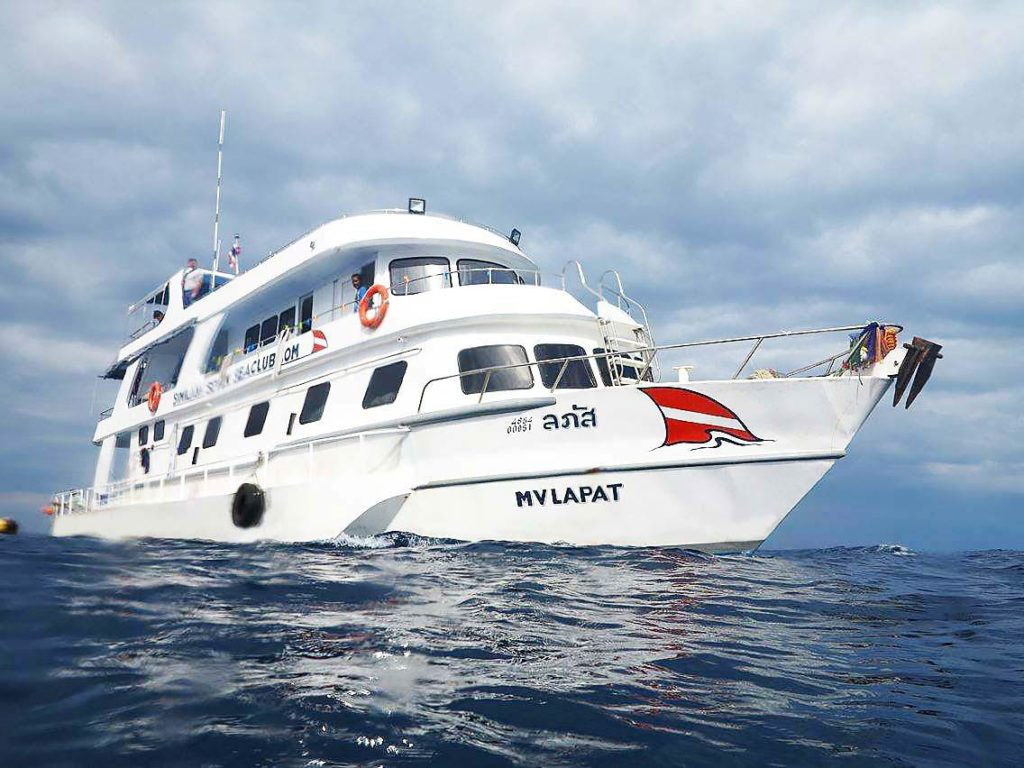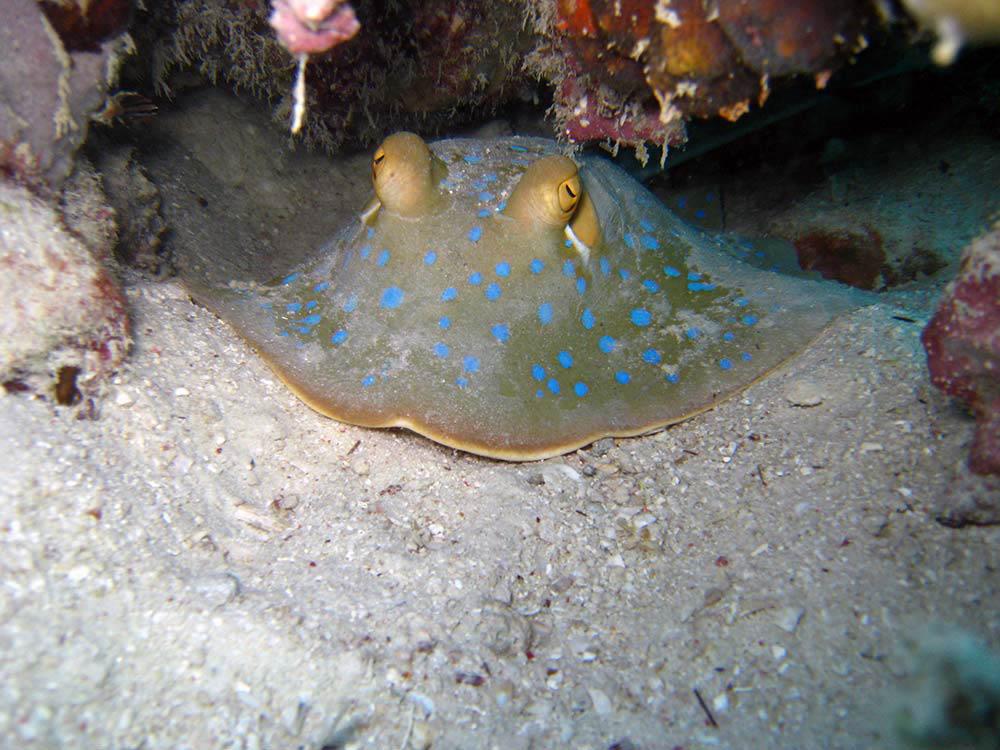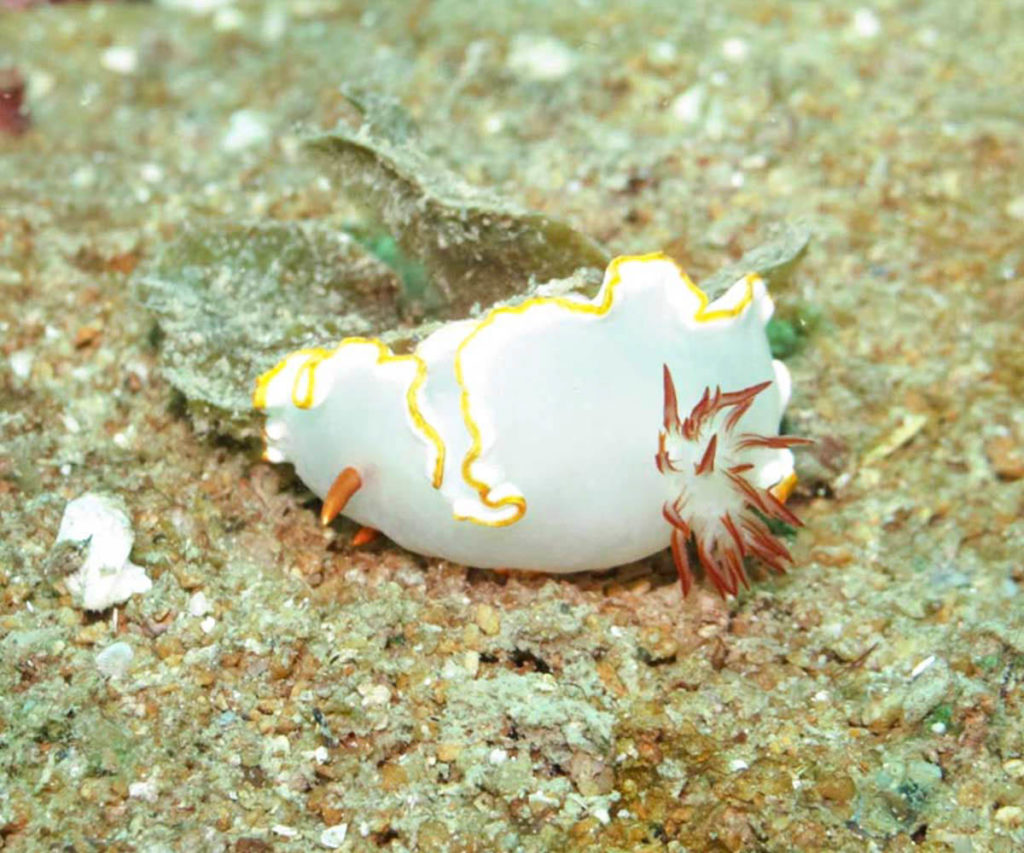A summary of all you need to know about scuba diving in Thailand. Where & when to learn to dive, how much to pay and info on Similan Islands liveaboards.
Thailand is among the best places in the world to go on vacation. Great weather, logistics, shopping, food, nightlife, and more. Scuba diving in Thailand is hugely popular due to the clear warm waters and colourful tropical reefs. You can learn to dive in Thailand, advance your certification level, or just go on fun dives on day trips or liveaboard cruises. Between dive trips, there’s plenty to see and do and the prices of getting around and staying in Thailand are very reasonable.
Before Covid-19 Thailand was among the most-visited countries in the world. And we hope that this continues when things return to normal. The country is especially attractive for those looking for some sea, sun, & fun at all budget levels. The country’s geographical location enables it to offer a great year-round climate. There are mountains, rainforests, shopping, nightlife and the famous islands & beaches in the south. Scuba diving in Thailand is incredibly popular. It’s ideal for learning to dive, day trips and liveaboard cruises. While some commercial diving is possible, this article focusses on recreational scuba diving.
- The Islands of Thailand
- Thailand’s best diving areas
- Types of dive boats
- Dive sites
- Learn to dive on a budget
- Prices
- Local guidelines, equipment & safety
- Booking a Thailand liveaboard
The Geography of Thailand

To get started, it’s important to understand the layout of southern Thailand, which is part of a peninsula that includes Malaysia on its southern border. On the east coast is The Gulf of Thailand, which leads out to The South China Sea. And on the west coast is The Andaman Sea that soon becomes The Indian Ocean. It is possible to sail from one coast to the other, but it’s a very long journey which requires sailing around Singapore and would take at least a week. At its narrowest point, the country is just 11 kilometres wide, and the peninsula’s narrowest section is just 50 kilometres wide. Travellers normally get from one side to the other by road or on domestic flights.
Islands in Thailand that you’ve probably heard of may include Phuket, Koh Phi Phi and The Similan Islands on the west/Andaman coast, and Koh Samui, Koh Tao, Koh Pha Ngan on the east coast. Phuket and Samui have international airports, but all the others are only reachable by private boat or public ferry.
Much of the marine life and sea conditions are very similar on one side of Thailand to the other, but the seasons are slightly different due to the monsoons. For most of us who want to escape winter, both sides of Thailand have great weather from December to March.
The Best Diving in Thailand
It’s generally considered that the best diving in Thailand is found off the west coast at what many refer to as The Similan Islands. Actually, the country’s best dive site is Richelieu Rock that’s technically in a national park just north of The Similans but is included in nearly all Similan Islands Liveaboard cruises anyway.
Why are The Similans & Richelieu Rock so good? Well, it’s mainly due to their location, far out at sea away from pollution and on the cusp of The Indian Ocean. The reefs are healthy, and large pelagic species come to visit on a regular basis. Everyone gets excited when a Whale Shark or Manta Ray joins the dive, and this is quite common at The Similans & Richelieu Rock.
It’s also possible to see these gentle giants at Chumpon Pinnacle and Sail Rock in The Gulf of Thailand, but these dive sites don’t usually have as good visibility, and they get crowded during high season. Phuket’s & Koh Phi Phi’s dive sites are also nice, but not as good as The Similans. And Phuket & Phi Phi dive sites get very busy during high season as well, normally with large groups of inexperienced divers.
Hin Daeng & Koh Haa are south of Phuket & Koh Lanta, and completely uninhabited. Diving here can be great for the healthy corals, marine life and lack of other dive boats.
Keep reading to learn about the type of boats & dive sites you can expect when diving in Thailand.
Dive Boats in Thailand
The type of boat you will dive from really all depends on how far away the dive site is. If not too many divers are going out for a one-dive trip, you can do this on a longtail boat with a back-roll entry. Two-dive day trips are done on larger dive boats if the destination is reachable within 90 minutes. But for travelling further, a speedboat or a catamaran fitted with outboard motors is necessary.
To enjoy the best Thailand diving experience, you should join a liveaboard cruise that goes out for three days or more. These large boats are smooth & very comfortable. Very few liveaboards operate on the east coast, mainly because there isn’t the choice of multiple & quality dive sites far from land but near one another. Most of the liveaboards operate on Thailand’s west coast.
Liveaboard cruises in Thailand usually start near or in Phuket, which means you can fly in on an international or domestic flight and be on the boat within a couple of hours. When considering the cost of a liveaboard trip, it’s important to remember that accommodation and meals are included. You get to dive up to four times each day, and this is really nice at dive sites which get busy. On a liveaboard you can dive before the day-trip boats arrive, and after they have gone back to shore.
Our next section discusses what types of dive sites you can expect to visit in Thailand.
Thailand Dive Sites
For recreational divers, the dive sites in Thailand are mostly coral reefs, with a few wrecks. In general, conditions are suitable for all levels of certified scuba diver. Around the islands and pinnacles, the sea usually bottoms out at approximately 25-35 metres. Some dive sites don’t get that deep, and a few go deeper.
In general, the boat operators can offer Open Water Divers plenty to see down to 18 metres, and Advanced Divers more life down to 30 metres, all while doing so on the same dive. In some cases, learning to dive or doing a discover/intro dive is possible at the same time & place as the experienced divers. But normally the shallow training dives take place at slightly different locations to ensure maximum safety, enjoyment & value.
The east and west sides of Thailand offer very similar experiences, but the visibility and marine life is usually better on the west (Andaman Sea) side. This is mainly due to the shape of The Gulf of Thailand, where water flow has a limited entry/exit. Plus, there are more container ships, tankers, international ports and oil fields in The Gulf. On the west side there’s almost no land all the way to India, and even Africa. This enables the sea currents to constantly provide new water and therefore maximise visibility. The East Coast of Thailand does have some wonderful and exciting dive sites, but the West Coast is consistently better.
Water temperatures vary very little. Expect 26-30°C pretty much all year round. Occasionally, there are periods when it can drop to 23-24°C, but not often. 3mm shorty wetsuits are the norm for rental gear. Some divers don’t bother with a wetsuit at all, while others claim to need a long wetsuit and hoody. It all depends on the diver’s personal preference, and what they have available to them.
Currents are not often too strong, like you may find in The Maldives or Komodo. Boat operators want happy divers, and strong currents don’t usually help this. Luckily, nearly all of Thailand’s recreational dive sites are generally easy regarding currents. One exception is Koh Tachai, in the Similan Islands. Here the currents are unreliable and range from nothing at all to very strong.
An important difference for some people when making comparisons is how much you will pay. Keep reading to find out why it’s so much cheaper to learn to dive on Koh Tao, compared to the rest of the country.
Learning to dive on a budget
The backpacker scene has been alive and well in Thailand for 30 years. Travellers on a budget want to get as much bang for their Buck as possible. Scuba diving centres on Koh Tao have been competing for business and growing in numbers ever since budget travellers started wanting to learn to dive in Thailand. The result of this is that prices for the Open Water Diver course have plummeted on Koh Tao. This has been exacerbated by SSI and RAID competing with PADI, who once had a bit of a monopoly.
It’s easy to get certified on Koh Tao for less than $300US, but at what real cost? Instructors get paid very little and they teach large groups. The reefs are overcrowded in high season, which has a negative effect on the ecosystem and the general enjoyment of everyone involved.
How good a diver can you become if you learn to dive on Koh Tao? That’s impossible to answer, but due to the sheer number of divers & dive centres, plus limited staff & time to complete courses, the chances are that you can get better training elsewhere.
Similar Pricing Around the Rest of Thailand
Completing scuba diving courses pretty much anywhere else in Thailand other than Koh Tao doesn’t vary too much in price. $400 is about the average price you can expect to pay for the Open Water course, and usually a bit less for the Advanced. Some islands, such as Koh Phi Phi, have a form of price fixing. This is done to ensure the Koh Tao model isn’t copied, and it encourages dive centres to focus on attracting business on their merits, not on their price. The result of this is maintaining quality, and the dive centres working together for the greater good.
Local Regulations, General Safety, Equipment & Logistics
Getting to Thailand and diving there is pretty simple for most people. There are very few regulations or things to worry about as long as you’re a healthy & conscientious diver. If you need to rent gear, most operators offer it, and getting around is quite easy.
Every scuba diver should know how to act in the water, for example not touching the reef or marine life. Use of things like gloves, strobes, & reef hooks shouldn’t have to be regulated because we should all behave responsibly. Quite rightly, Thailand’s national marine parks prohibit fishing, touching marine life, or even learning to dive in some areas. Each marine park makes its own policies clear, and responsible dive centres make sure that their staff and guests abide by the rules.
Although the roads and drivers in Thailand are infamously dangerous, the boats & dive operations have a pretty-good safety record. Nearly all dive centres are run by westerners. Like in most countries, the boat captains are responsible for everyone on board, and therefore they tend to have a lot to lose if something goes wrong. Accidents can happen in any country, but scuba diving in Thailand has a very good safety record.
Many thousands of people enjoy scuba diving in Thailand, and at least half of them use the rental equipment provided by the dive centres. BCDs, regs, wetsuits, fins and masks are all available to hire, and in most cases are in good condition due to regular servicing and replacements. Nitrox is available at 70% or more of the dive centres, and in many cases it’s free of charge. Tanks are always supplied and included in the price. Depending on the dive centre, these are INT or DIN tanks, with adaptors available if your regs don’t match what they have.
Getting around Thailand is easy and inexpensive. The rail network is limited and trains are slow, but roads are in good condition, ferries tend to be reliable, and the low-cost domestic airlines are great. As a South-East Asian country, punctuality in Thailand has a slightly different meaning when compared to westerners’ ideas, but in general things work fine. Many dive centres offer a free or cheap transfer service from local hotels.
When, and exactly where, you plan to go scuba diving in Thailand probably depends on many things. For example, Covid travel restrictions, your annual vacation, your budget, or your family.
Do you need to prebook your scuba diving liveaboard, fun dives or course? Yes and no. For courses and day trip fun dives you can normally book a few days in advance, and therefore when you have already arrived in Thailand. But for a Thailand liveaboard, it’s better to book in advance. Yes, there are some last-minute special offers, but there are also plenty of early-bird deals. Also, the nicest cabins on better boats during peak season usually fill up months before departure.
In Summary
Thailand is a wonderful country for many reasons, and its great scuba diving options are an extra reason to travel there. Learning to dive is cheap, and the day trips and courses can usually be booked a day or two before you start. For the best diving in Thailand, a liveaboard cruise on the west coast is the way to go, but you should always book this in advance. To do this, a local agent normally gives you the best service and information. Worldwide agents are not specialized enough. And booking directly will never enable you to get independent advice and neutral information. Similan Diving Tours is a trusted online agent based in Thailand with years of experience, a wide range of options, and a great deal.
Article Submitted by Jamie Dodson
Jamie is associated with Similan Islands Diving Liveaboards and








1 Comment
Thailand’s underwater world is a diver’s paradise, and I had the privilege of exploring some incredible dive sites there. While popular spots like the Similan Islands and Koh Tao offer remarkable diving experiences, I also discovered hidden gems worth mentioning. Koh Lipe, with its vibrant coral reefs, and the Surin Islands, known for their pristine conditions and diverse marine life, were unforgettable destinations. When planning your dive trip, be sure to research reputable dive centers that prioritize safety and environmental conservation.